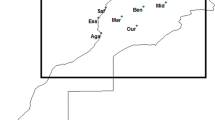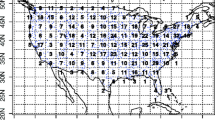Abstract
Two different groups of indices have been defined to analyze the evolution of global temperature between 1958 and 1998. All the indices were evaluated at three different levels (850, 500 and 200 hPa), and averaged indices were calculated using the whole globe, continental areas and oceanic areas. The first group of indices analyzes the area of the world covered with higher and lower than normal temperatures, detecting a slight cooling in the 200 hPa level. The second group of indices studies the annual frequency of extreme events, and again, it is at 200 hPa where the most intense variation is detected. Finally, an analysis is performed to determine the regions most sensible to variations in the occurrence of extreme events. Tropical areas are mostly responsible of the variations detected in the second group of indices.
Similar content being viewed by others
References
Angell J.K., 1999. Variation with height and latitude of radiosonde temperature trends in North America, 1975–94. J. Climate, 12, 2551–2561.
Bengtsson L., Roeckner E. and Stendel M., 1999. Why is the global warming proceeding much slower than expected? J. Geophys. Res., 105, 3865–3876.
Cai W. and Whetton P.H., 2001. Modes of SST variability and the fluctuation of global mean temperature. Clim. Dyn., 17, 889–901.
Easterling D.R., Horton B., Jones P.D., Peterson T.C., Karl T.R., Parker D.E., Salinger M.J., Razuvayev V., Plummer N., Jamason P. and Folland C.K., 1997. Maximum and minimum temperature trends for the globe. Science, 277, 364–367.
Gaffen D.J., Santer B.D., Boyle J.S., Christy J.R., Graham N.E. and Ross R.J. 2000. Multidecadal changes in the vertical temperature structure of the tropical troposphere. Science, 287, 1242–1245.
Hansen J., Sato M., Glascoe J. and Ruedy R., 1998. A common-sense climate index: Is climate changing noticeably? Proc. Natl. Acad. Sci. USA, 95, 4113–4120.
Hansen J., Ruedy R., Glascoe J. and Sato M., 1999. GISS analysis of surface temperature change. J. Geophys. Res., 104, 30997–31022.
Hansen J., Ruedy R., Sato M. and Lo K., 2002. Global warming continues. Science, 295, 275–275.
Hurrell J.W. and Trenberth K.E., 1998. Difficulties in obtaining reliable temperature trends: reconciling the surface and satellite microwave sounding unit records. J. Climate, 11, 945–967.
Jones P.D., New M., Parker D.E., Martin S. and Rigor I.G., 1999a. Surface air temperature and its changes over the past 150 years. Rev. Geophys., 37, 173–199.
Jones P.D., Horton E.B., Folland C.K., Hulme M., Parker D.E. and Basnett T.A., 1999b. The use of indices to identify changes in climatic extremes. Clim. Change, 42, 131–149.
Jones P.D. and Moberg A., 2003. Hemispheric and large-scale surface air temperature variations: an extensive revision and update to 2001. J. Climate, 16, 206–223.
Kalnay E., Kanamitsu M., Kistler R., Collins W., Deaven D., Gandin L., Iredell M., Saha S., White G., Woollen J., Zhu Y., Chelliah M., Ebisuzaki W., Higgins W., Janowiak J., Mo K.C., Ropelewski C., Wang J., Leetmaa A., Reynolds R., Jenne R. and Joseph D., 1996. The NCEP/NCAR 40-year reanalysis project. Bull. Amer. Meteorol. Soc., 77, 437–471.
Karl T.R., Knight R.W., Easterling D.R. and Quayle R.G., 1996. Indices of climate change for the United States. Bul. Am. Met. Soc., 77, 279–292.
Kistler R., Kalnay E., Collins W., Saha S., White G., Woollen J., Chelliah M., Ebisuzaki W., Kanamitsu M., Kousky V., van den Dool H., Jenne R. and Fiorino M., 2001. The NCEP-NCAR 50-year reanalysis. Monthly means CD-ROM and documentation. Bull. Amer. Meteor. Soc., 82, 247–267.
Parker D.E., Jones P.D., Folland C.K. and Bevan A., 1994. Interdecadal changes of surface temperature since the late nineteenth century. J. Geophys. Res., 99, 14,373–14,399.
Santer B.D., Wigley T.M.L., Gaffen D.J., Bengtsson L., Doutriaux C., Boyle J.S., Eseh M., Hnilo J.J., Jones P.D., Meehl G.A., Roeckner E., Taylor K.E. and Wehner M.F., 2000. Interpreting differential temperature trends at the surface and in the lower troposphere. Science, 287, 1227–1232.
Stott P.A., Tett S.F.B., Jones G.S., Allen M.R., Mitchell J.F.B. and Jenkins G.J., 2001. Attribution of twentieth century temperature change to natural and anthropogenic causes. Clim. Dyn., 17, 1–21.
Timmermann A., 1999. Detecting the nonstationary response of ENSO to greenhouse warming. J. Atm. Sci., 56, 2313–2325.
Vuille M. and Bradley R.S., 2000. Mean annual temperature trends and their vertical structure in the tropical Andes. Geophys. Res. Let., 27, 3885–3888.
Author information
Authors and Affiliations
Rights and permissions
About this article
Cite this article
Ribera, P., Gimeno, L., Gallego, D. et al. Two Approaches for Determining Extreme Years of Global Atmospheric Temperature. Studia Geophysica et Geodaetica 48, 447–458 (2004). https://doi.org/10.1023/B:SGEG.0000020840.15909.37
Published:
Issue Date:
DOI: https://doi.org/10.1023/B:SGEG.0000020840.15909.37




